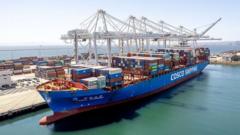The initiative raises concerns about disruptions in global trade as it threatens to elevate costs for American consumers already affected by existing tariffs.
**US Strategizes Port Fees on Chinese Vessels to Boost Shipbuilding Industry**

**US Strategizes Port Fees on Chinese Vessels to Boost Shipbuilding Industry**
The US aims to impose port fees on Chinese ships to stimulate local shipbuilding and counter intently rising Chinese shipping dominance.
The United States has announced plans to introduce port fees for Chinese vessels, a move that aims to support domestic shipbuilding while challenging China's expanding influence in maritime trade. This initiative, rolled out by the US Trade Representative (USTR), is positioned as a strategic response to what the Trump administration views as unfair advantages held by Chinese companies.
According to the USTR, the initial implementation of these fees will commence in 180 days and are set to gradually increase over the next few years. The measure is framed as a part of broader tariff policies that have elicited mixed reactions from global trade experts, especially given their potential to disrupt international shipping lanes—an area already fraught with challenges.
The proposed fees structure will vary based on the types of vessels and the nature of their cargo. For instance, bulk carriers from China will incur a charge of $50 per ton of cargo, with annual hikes of $30 for the subsequent three years. Similarly, container ships will face fees based on the number of containers, starting from $120 per container. Notably, provisions exempt certain classes of vessels, including those that transport coal or grain, in a bid to mitigate the impacts on specific trade routes.
The announcement aligns with recent trends indicating a shift in cargo routes, as vessels originally scheduled for US ports are increasingly being diverted to European destinations. Experts have noted that the diversion of goods has already led to increased port congestion, particularly in the UK and European markets. The USTR’s decision comes amidst broader tariff strategies that have seen duties on specific goods rise to unprecedented levels.
With these tariffs and fees in place, analysts warn that ends consumers in the US are likely to bear the burden through rising prices on imported goods, while European consumers might experience minimal direct effects. Logistics firms have indicated that the strategy could compel businesses to reevaluate their supply chains in anticipation of continued disruptions.
As the global trade landscape evolves under these pressures, the implementation of port fees represents a critical development in the ongoing trade conflict between the US and China, signaling potential long-lasting impacts on international shipping dynamics.
According to the USTR, the initial implementation of these fees will commence in 180 days and are set to gradually increase over the next few years. The measure is framed as a part of broader tariff policies that have elicited mixed reactions from global trade experts, especially given their potential to disrupt international shipping lanes—an area already fraught with challenges.
The proposed fees structure will vary based on the types of vessels and the nature of their cargo. For instance, bulk carriers from China will incur a charge of $50 per ton of cargo, with annual hikes of $30 for the subsequent three years. Similarly, container ships will face fees based on the number of containers, starting from $120 per container. Notably, provisions exempt certain classes of vessels, including those that transport coal or grain, in a bid to mitigate the impacts on specific trade routes.
The announcement aligns with recent trends indicating a shift in cargo routes, as vessels originally scheduled for US ports are increasingly being diverted to European destinations. Experts have noted that the diversion of goods has already led to increased port congestion, particularly in the UK and European markets. The USTR’s decision comes amidst broader tariff strategies that have seen duties on specific goods rise to unprecedented levels.
With these tariffs and fees in place, analysts warn that ends consumers in the US are likely to bear the burden through rising prices on imported goods, while European consumers might experience minimal direct effects. Logistics firms have indicated that the strategy could compel businesses to reevaluate their supply chains in anticipation of continued disruptions.
As the global trade landscape evolves under these pressures, the implementation of port fees represents a critical development in the ongoing trade conflict between the US and China, signaling potential long-lasting impacts on international shipping dynamics.






















